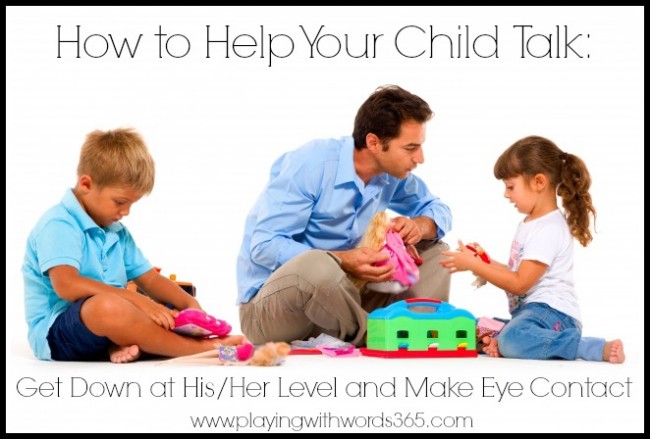Welcome to my How to Help Your Child Talk series. These posts are intended to give you simple tips to help you work with your child so YOU can be your child’s best “speech therapist.†You may want to try out a new tip/strategy for a week or so and then when you feel like you’ve “got it† and it comes more naturally, move on to a new tip and incorporate that into your day for another week or two. For a list of  all my tips, go HERE. This post contains affiliate links to Amazon for your convenience.Â

Get Down at Your Child’s Level
Just like on my last tip (Slow Down and Be Present) I talk about getting down at your child’s level in my popular guest post at Toddler Approved 5 Tips to Help Your Child Learn Language and Communicate. This is another tip that seems so simple yet is so effective is helping your child on his path to communication.
I want you try something. Sit down on the floor, and then have your partner or a friend stand about 2-3 feet from you. Now….have a conversation. About whatever you want, but stay on the floor. Do this for a good 3-5 minutes. Then switch roles so you each get a turn.
Now tell me, how did you feel? Did you feel really engaged in the conversation, or were you thinking too much about how your neck hurt from looking up to even be able to really pay attention? Were you able to hear your communication partner well? Are you feeling refreshed/happy or a bit tired after this short conversation?
This is what it feels like to be a very small child. They are constantly having to look up at you when you speak, which not only can hurt their neck and be generally uncomfortable, but can actually distract them from the message you are sending. Your child is less likely to be able to listen, focus, understand and learn from communications that are *literally* above their head than if you simply get down at their level.
Make Eye Contact
Once you squat down so that you are face to face with your child, make eye contact so that you know your child is attending to you. Young children will not always make direct eye contact for very long…this is OK! Just making that quick connection is important. Get face to face as often as you can, attempt eye contact and look at your child’s face/eyes when you speak to him/her.
**A note on eye contact: Some children, especially those on the autism spectrum, find eye contact very difficult. Do not make your young child maintain eye contact with you as you speak to him, just attempt to make eye contact and then begin your message. At the least, just make sure you are face to face whenever possible. If your child has great difficulty with making and maintaining eye contact, be sure to talk to your pediatrician.Â
Now, I’m asking YOU to try this. For the next few days, get down at your child’s level when you speak to him/her. Look him in the eyes and try to really connect. Then come back and tell me how it went! For a list of  all my other tips, go HERE.
Looking for more ways to help with your child’s speech and language development? ? I highly recommend these two books: My Toddler Talks: Strategies and Activities to Promote Your Child’s Language Development by fellow SLP and friend Kim Scanlon and It Takes Two To Talk: A Practical Guide For Parents of Children With Language Delays
 from The Hanen Centre.
DISCLAIMER: My tips are for informational purposes only and do NOT replace the interventions of a licensed and certified speech-language pathologist. Please read my full disclaimer and terms of use page for more information.Â
[…] Some children have a tendency to learn that their parent will not follow through with what they have commanded until the third time of telling them to. The first thing a parent thinks to do when a child disobeys is yell across the room. Instead, try and not yell across the room for your child do something, instead get on their level and speak clearly to them. […]